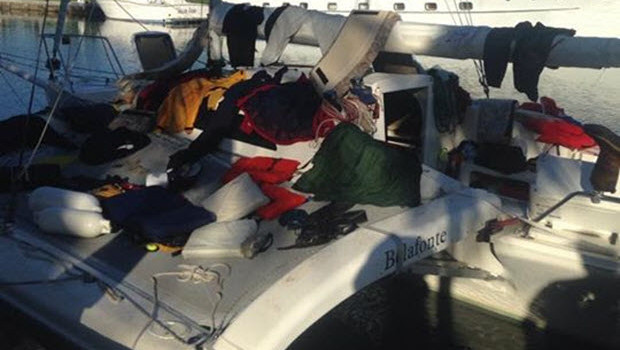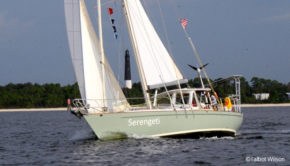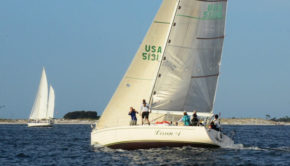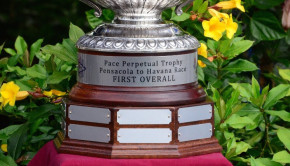USA to Cuba: Mission Accomplished
Published on November 4th, 2015
(November 4, 2015) – The Corsair 31R trimaran, ‘Bellafonte’, was the first overall to finish in the 2015 Andrews Institute Pensacola a la Habana Race. ‘Bellafonte’ led the Multihull Division out of Pensacola Bay on Saturday October 31st and completed the 511 nautical mile (nm) rhumb-line course at 2:06:41 AM on Wednesday morning November 4th. She finished after almost four days, and she actually sailed some 650nm tacking most of the way to Marina Hemingway.
‘Bellafonte’, sailing not so close to the wind… as multihulls do, had a long wet ride. The little tri— sailed by Pensacola skipper Mike Patterson and crew PeeWee Chason, David Johnson and Andrew McMillan— went from Pensacola to near Tampa Bay before catching wind shifts that enabled them to take some long Cuba-friendly tacks south to cross first on elapsed time. With a -30 seconds-per-mile handicap in their division, how they will do on corrected time is another matter.
Megan McMillan talked to her husband Andrew. She reported he said, “I’m glad it is all over. The best part was Tuesday night sailing at over 18kts across the Gulf Stream. The worst part was the first two nights with waves entering the bow hatch. We cut one of the water jugs to bail out water from the main hull and used a nalgene [bottle] to bail out the amas [multihull for pontoons].”
“I ended up duct taping the bow hatch closed,” Said McMillan, “to stop or at least slow the water.”
Megan McMillan said the ‘Bellafonte’ crew were bruised and tired, but happy to be in Cuba.
‘Bene Vita’— the second multihull to finish— has a 177 seconds-per-mile handicap in that division. She finished at 12:28:08 PM Wednesday. Initially, reports indicated she ‘apparently’ might have used her engine through the light air on Tuesday to help get to Cuba quicker. Engine use is allowed in this race, but incurs a stiff handicap-based penalty… adjusting the handicap time allowance by a correction factor and by the amount of time the engine runs in gear.
Members of the ‘Bene Vita’ team on land and ashore have assured reporters that they did not use their engine for propulsion.
Christine Reiss on board ‘Bene Vita in Cuba texted, “We saw winds from 8 to 40 knots, almost always on the nose. We opted to go east for the wind, as opposed to west for the current. Blew out a jib sheet, broke a mainsail car and a main sheet block, and had intermittent electrical problems. Despite all, had a blast! We did not motor during any part of the Pensacola a la Habana Race.”
Catherine Zehner, a leader of the shore team wrote, “This is a great team and it was absolutely riveting to watch the trackers on these boats. I don’t think I slept more than three hours the entire time they were at sea. In fact, when they slowed down to haul in a blackfin tuna, I texted them to quit fishing and keep racing because the competition had .8 kn of speed on them. That’s how closely the onshore team was monitoring them.”
“They had a phenomenal race – sailing more than 700 miles over the Gulf of Mexico. The proud wife in me just wanted everybody else to know it too.”
The first monohull to finish was the scratch boat in that division, ‘Lesson #1’ a J130 from New Orleans, LA sailed by co-skippers Guy Williams and Mike Finn and their crew of Troy Gilbert, Morgan Mayberry, Anthony Bartlett, Bryan Whited, Randall Richmond, and Claire Miller. Despite a broken alternator and a blown out mainsail (repaired and nicknamed ‘frankensail’), they finished as the first monohull at 8:05:50 AM Wednesday. ‘Lesson’ did not use her engine except to charge her battery… until the alternator went out and there was no need. They charged with a solar panel from there.
‘Libra’, a Tripp 57 from Orange Beach, AL, was the second monohull. She followed 15 minutes behind ‘Lesson #1’. Her handicap is 177 vs. +30 for ‘Lesson’. With that finish time, ‘Libra’ would normally beat ‘Lesson’ by many hours on corrected time, but apparently, like the cat ‘Bene Vita’, she used her engine for propulsion and will have to accept a penalty.
Several of the boats that have finished— and many still on the course— have used their engines for propulsion. Calculating the adjusted corrected times of all the boats will be complex.
One boat, the handmade catamaran ‘Surf Rider’, returned to Pensacola Bay and must have motored much of the way east through the Intracoastal Waterway to re-enter the Gulf at Apalachicola. She then headed south continuing her route to Cuba.
According to reports from family member ashore, ‘Surf Rider’ claims to be racing still. There are no rules against this as long as the vessel sails the proper course for the race, including leaving the course marks #14 and #12 at the mouth of Pensacola Bay to the proper side both exiting and re-entering the bay. Deciding the proper side is governed by the definition of a proper course in the Racing Rules of Sailing.
By mid-afternoon ‘Learning to Fly’, ‘Odalisque’, ‘XTC’ and ‘Serengeti’ had finished. ‘Legacy’ is next in line with a 10:00PM ETA. That will leave seven boats on the course racing and three that have retired but are on the course heading for Cuba, too.
Listed are approximate finishing times according to Pensacola Past Commodore Larry Bowyer—
Legacy – 10:00 pm EST
Chanty – 12:00 midnight EST
NaZadrvi – 4:00 am EST, 05/11/15
Tif Blue – 5:00 am EST, 05/11/15
Acadia – 5:00 am EST, 05/11/15
Deja Vu – 10:00 am EST, 05/11/15
The usual trade winds have built back across the southern part of the course to Cuba on Wednesday. Those winds will be from the east and will be going directly against the Gulf Stream that flows through the Florida Straights, between the Florida Keys and Cuba. By late afternoon winds on the southern part of the course where most of the boats are had built to 15-20kts from the east.
CORRECTION: The story above has been corrected, as it previously stated that ‘Bene Vita’ – the second multihull to finish – had apparently used her engine during the race. She in fact never used her engine.
Report by Talbot Wilson
Editor’s note: Cuba Libre is the simplest of Cuban cocktails, no more than white rum with cola and a twist of lime. It was given its name (“Free Cuba”) in 1902 after the country had broken free from Spanish colonial rule.
Course: The 2015 race is 511 nautical miles from Pensacola to Havana. The new race started October 31 with the tide at the end of the Bayou Chico Channel, heads through Pensacola Pass, leaves the sea buoy #1 to starboard and heads straight to Havana leaving Rebecca Shoals Light to port. Twenty-one boats are competing in three divisions — 10 Modern Cruisers, 7 Classic Cruisers, and 4 Multihulls.









 We’ll keep your information safe.
We’ll keep your information safe.